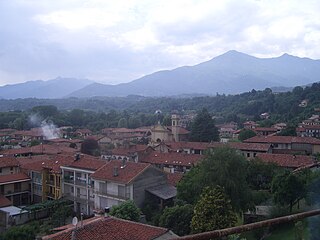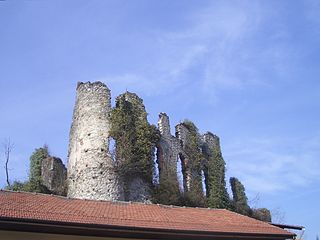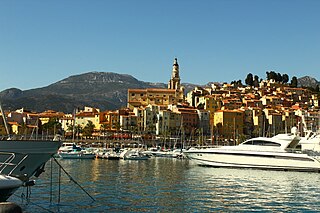
Clan Campbell is a Highland Scottish clan. Historically one of the largest and most powerful of the Highland clans, their lands were in Argyll and the chief of the clan became the Earl and later Duke of Argyll.

Moncalieri is a town and comune of 57,518 inhabitants about 8 kilometres (5 mi) directly south of downtown Turin, in Piedmont, Italy. It is notable for its castle, built in the 12th century and enlarged in the 15th century, which later became the favorite residence of Maria Clotilde and Victor Emmanuel II of Italy. It is part of the World Heritage Site Residences of the Royal House of Savoy.
Semper fidelis is a Latin phrase that means "always faithful" or "always loyal". It is the motto of the United States Marine Corps, usually shortened to Semper Fi. It is also in use as a motto for towns, families, schools, and other military units.

Clan MacNeil, also known in Scotland as Clan Niall, is a highland Scottish clan, particularly associated with the Outer Hebridean island of Barra. The early history of Clan MacNeil is obscure, however despite this the clan claims to descend from the legendary Irish King Niall of the nine hostages. The clan itself takes its name from a Niall who lived in the 13th or early 14th century, and who belonged to the same dynastic family of Cowal and Knapdale as the ancestors of the Lamonts, MacEwens of Otter, Maclachlans, and the MacSweens. While the clan is centred in Barra in the Outer Hebrides, there is a branch of the clan in Argyll (McNeill/MacNeill) that some historians have speculated was more senior in line, or possibly even unrelated. However, according to Scots law the current chief of Clan Macneil is the chief of all MacNeil(l)s.

Clan Maclaine of Lochbuie is a Scottish Clan that inhabited lands on the southern end of the Isle of Mull in the Inner Hebrides of the western Scottish Highlands. "Maclaine" is an alternate spelling for "McLean." Clan Maclaine of Lochbuie and Clan Maclean of Duart are two separate clans. However, the two clans share a strong family connection. The 26th clan chief is The Much Honoured Lorne Gillean Ian Maclaine of Lochbuie, Baron of Moy. The clan is recognized by both the Standing Council of Scottish Chiefs and the Lord Lyon.

The House of Burnett is a Lowland and Border Scottish family composed of several branches. The Chief of the Name and Arms of Burnett is James Comyn Amherst Burnett of Leys, Baron of Kilduthie. They are from Deeside, near Banchory, in Northeast Scotland. From the early 14th century to the mid 16th century the family occupied a lake dwelling on the Loch of Leys, and resided there or on land near the lake for over 200 years. It is from this lake that the family eventually acquired the designation "of Leys".

The Residences of the Royal House of Savoy are a group of buildings in Turin and the Metropolitan City of Turin, in Piedmont. It was added to the UNESCO World Heritage Sites list in 1997.

Castellamonte is a comune (municipality) in the Metropolitan City of Turin in the Italian region Piedmont, located about 35 kilometres (22 mi) north of Turin.

Cirié is a comune (municipality) in the Metropolitan City of Turin in the Italian region Piedmont, located about 20 kilometres (12 mi) northwest of Turin.

Rocca Canavese is a comune (municipality) in the Metropolitan City of Turin in the Italian region Piedmont, located about 30 kilometres (19 mi) northwest of Turin.

Santena is a comune (municipality) in the Metropolitan City of Turin in the Italian region Piedmont, located about 15 kilometres (9 mi) southeast of Turin on the right bank of the Po.

Borghetto di Borbera is a comune (municipality) in the Province of Alessandria in the Italian region Piedmont, located about 110 kilometres (68 mi) southeast of Turin and about 35 kilometres (22 mi) southeast of Alessandria.

Clan Moffat is a Lowland Scottish clan of ancient origin. The clan was leaderless and obscure from the mid 16th century until 1983, when Francis Moffat of that Ilk was recognised as the hereditary chief of the clan by Lord Lyon King of Arms.

The Castle of Moncalieri is a palace in Moncalieri, Piedmont, in northern Italy. It is one of the Residences of the Royal House of Savoy listed by UNESCO as World Heritage Sites in 1997.

The Aleramici were a medieval Italian noble family of Frankish origin which ruled various northwestern counties and marches, in Piedmont and Liguria from the tenth to the 14th century.

Clan Spalding is a highland Scottish clan and sept of Clan Murray. The clan does not have a chief recognised by the Lord Lyon King of Arms so the clan is considered an armigerous clan. The Spalding family lived in Perthshire, Scotland, for several hundred years before 1745, and dispersed to Germany, Sweden, Jamaica, Georgia, Liverpool, Virginia and elsewhere. The Castle of Ashintully was the clan centre in Perthshire.

Merode is one of the most important families of the Belgian nobility.
Giovanni Stefano Verdura was a 17th-century Italian painter of the Baroque period, mainly active in Genoa and later in the Piedmont. He was a disciple of the Genoese painter Domenico Fiasella. He died of the plague in 1657.
Croom or Crom Castle, also called the Castle of Crom, is a historic castle in the town of Croom, County Limerick, that is notable for its occupation as one of the principal residences of the Kildare branch of the FitzGerald dynasty. Their ancient war cry and motto "Crom a Boo", or in Irish "Crom Abu" or Crom forever, comes from the strategic fortress. Before the FitzGeralds it was the site of an earlier fortress of the O'Donovans.

The Malaspina was a noble Italian family of Longobard origin that descending from Boniface I, Margrave of Tuscany, through the Obertenghi line that ruled Lunigiana from the 13th to the 14th century through many feuds, and since the 14th century the marquisate of Massa and lordship of Carrara, which later became the Duchy of Massa and Carrara and at a later time the Principality of Massa and the Marquisate of Carrara.






















